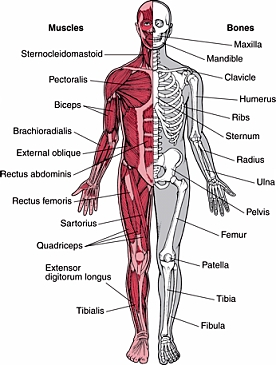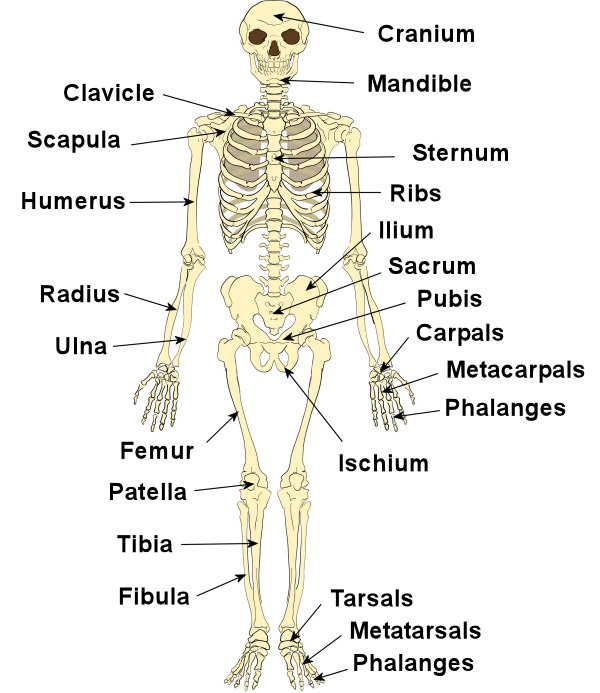английский за проф направлением. Укладач Триполець В.І. Рецензенти
 Скачать 4.04 Mb. Скачать 4.04 Mb.
|
|
Answer the following questions. 1. What are the principal parts of the human body? 2. How many parts does the head consist of? 3. What does the skull contain? 4. What does the face consist of? 5. What is there in the mouth? 6. What are the principal parts of the ear? 7. What connects the trunk with the head? 8. How is the upper part of the trunk called? 9. What are the principal organs in the chest? 10. What are the principal organs in the abdominal cavity? III. Speaking l. Can you do these tasks on your own?
2. Tell about the functions of the organs as in the example.
A Bit of Humour "The doctor said he'd have me on my feet in a fortnight." "And did he?" "Sure, I've had to sell my car." Dentist (to a talkative patient): "Open your mouth and shut up." "It's one thing to itch for something and another to scratch for it." 44. The Musculoskeletal System. Кістково-м'язова система. I. Vocabulary. 1. Readandlearnthetopicalvocabulary. bone— кістка; cartilage— хрящ; tendon— сухожилля; ligament— зв'язка; joint— суглоб; skull— череп; jaw— щелепа; sternum (breastbone) — грудина; rib— ребро; vertebra— хребець; pelvis— таз; coccyx— куприк; limb— кінцівка; extremity— кінцівка; humerus— плечова кістка; ulna— ліктьова кістка; radius— променева кістка; clavicle— ключиця; scapula— лопатка; femur— стегно; tibia— великогомілкова кістка; fibula— малогомілкова кістка; соха — тазостегновий суглоб; muscles— м'язи. 2. Read and memorize some interesting facts about the human skeleton.
Did you know that humans and giraffes have the same number of bones in their necks? Giraffe neck vertebrae are just much, much longer! 3. Match the following English word combinations with the Ukrainian ones:
4. Find substitutes for the following terms:
f) 12 vertebrae in the mid-back, below the cervical vertebra and above the lumbar vertebrae. II. Reading. 1. Read the text. THE MUSCULOSKELETAL SYSTEM  The skeleton and muscles function together as the musculoskeletal system. This system (often treated as two separate systems, themuscular,and skeletal)provides form, stability, and movement to the human body. It is made up of the body's bones(the skeleton), muscles, cartilages, tendons, ligaments, joints,and other connective tissue (described as the tissue that supports and binds tissues and organs together). The musculoskeletal system's primary functions include supporting the body, allowing motion, and protecting vital organs. The skeletal portion of the system serves as the main storage system for calcium and phosphorus and contains critical components of the hematopoietic system 2. Read and translate the following text. Get ready to speak on the structure of the human skeleton using the pictures and anatomic terms. THE HUMAN SKELETON From our head to our toes, our bones provide support for our bodies and help to form our shape. The skull protects the brain and forms the shape of our face. The spinal cord, a pathway for messages between the brain and the body, is protected by the backbone, or spinal column. The average human adult skeleton consists of 206 bones, attached to the muscles by tendons. Babies are bom with 270 soft bones — about 64 more than an adult. These will fuse together by the age of twenty or twenty-five into the 206 hard, permanent bones. Bone building continues throughout life, as a body constantly renews and reshapes the bones' living tissue. The skeleton has two main parts: the axial skeleton and the appendicular skeleton. The axial skeleton consists of the skull, the spine, the ribs and the sternum (breastbone) and includes 80 bones. The appendicular skeleton, consists of 126 bones, includes two limb girdles (the shoulders and pelvis) and their attached limb bones.  Axial skeleton (80 bones) - skull — consisting of 1) the cranium (which encloses and protects the brain) and 2) the facial skeleton; - jaw — the only freely movable bone of the skull; - ribs, sternum (breastbone) — comprising the "thorax'Vchest, protecting the heart and lungs; - vertebral column — the "spine". The vertebral column transmits the body weight from the head, thorax, and abdomen to the lower extremities and encloses and protects the spinal cord. The vertebral column has three groups of vertebrae and two sets of fused bones. These vertebrae include seven cervical (neck) vertebrae, twelve thoracic (upper back) vertebrae, and five lumbar (lower back) vertebrae. Five fused vertebrae form the sacrum and from three to five fused small vertebrae form the coccyx (tail bone). The vertebrae form a column of bone that protects the spinal cord. The thoracic vertebrae have facets (indentations) upon their surfaces that articulate (meet) with the ribs. The ribs form a cage that shelters the heart, lungs, liver, spleen, and pelvis helps to protect the bladder, intestines, and in women, the reproductive organs. Although they're very light, bones are strong enough to support our entire weight. Appendicular skeleton consists of the pectoral girdle, the upper limbs, pelvic girdle, the lower limbs (126 bones, 64 in the shoulders and upper limbs and 62 in the pelvis and lower limbs):
- pelvic girdle consists of two hip bones; each hip bone forms from fused bones. The two coxae, sacrum, and coccyx form the pelvis, a bowl-shaped cavity that supports and protects many abdominal organs; - lower extremity (the femur, the tibia, the fibula, the foot). Bones are fastened to other bones by long, fibrous straps called ligaments. The joints allow the bones to move. Cartilage, a flexible, rubbery substance in our joints, supports bones and protects them where they rub against each other. Bones are made up of calcium, phosphorus, sodium, and other minerals, as well as the protein collagen. Calcium is needed to make bones hard, which allows them to support body weight. Bones also store calcium and release some into the bloodstream when it's needed by other parts of the body. The amounts of certain vitamins and minerals that you eat, especially vitamin D and calcium, directly affects how much calcium is stored in the bones. The soft bone marrow inside many of the bones is where most of the blood cells are made. III. Post-reading activities. 1. Answer the following questions.
2. Fill in the blanks with the words given under the line.
 a) bone marrow; b) birth; d) clavicle; e) support; e) the spinal cord; f) jaw; g) ligaments; h) brain 3. Group the words according to the skeleton parts.
Hand, pelvis, skull, the tibia, jaw, coccyx, ulna, femur, rib, humerus, the cranium, thoracic vertebrae, foot, scapula, breastbone. 4. Put proper numerals in the blanks.
h) There are ... vertebrae in the sacral part of the spine. 5. Read and memorize the English idioms containing some topical words. Make your own sentences with the idioms. BONE
ARM
CHEST • to get smth off one's chest — to admit or tell smth to smb which was worrying one and which one did not want to talk about previously because it was unpleasant — полегшити душу; щиросердно зізнатися BACK • to break the back of smth (usually of a job or some kind of work) — to finish the greater or most difficult part of the work
|
